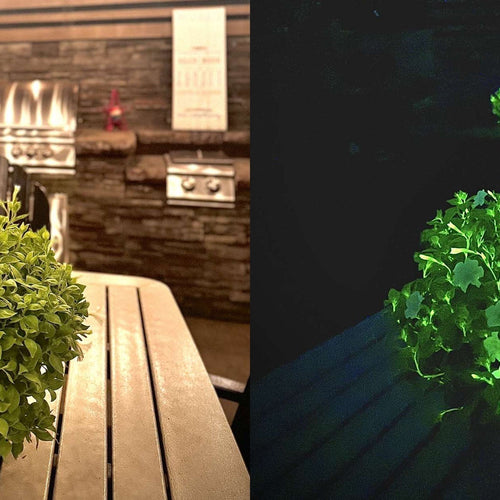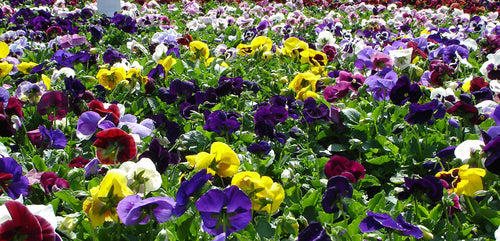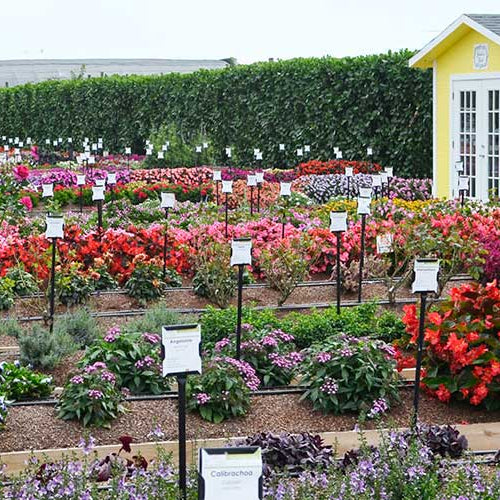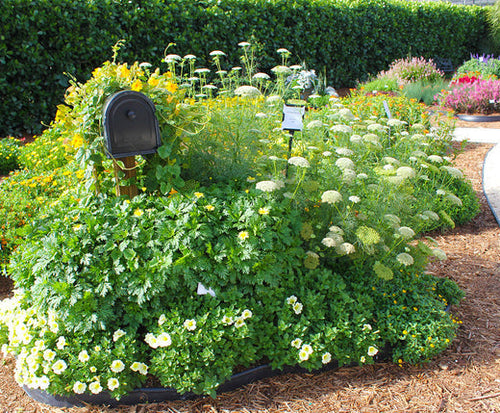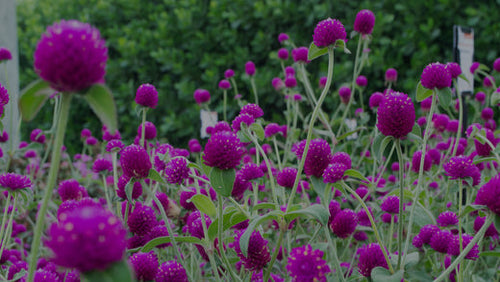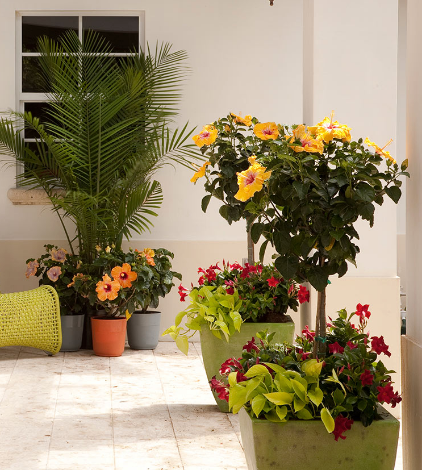
Build in Layers
Short, medium, and tall plants combine beautifully to create levels of interest in the garden. Here’s one easy way to achieve that. We started with sedum Voodoo, a wonderfully durable perennial offering purple-flushed leaves that hold their color from spring to autumn. Rising from behind the sedum is another perennial: yarrow Noblessa, a fun variety that features baby’s-breath-like flowers. Like other types of yarrow, it’s wonderfully tough, holding up to heat and drought.
We’ve also tossed in a few salvia Summer Jewel Pink, a floriferous little annual that offers white flowers with a coral-pink lip. For height in the back, we have to more pink flowers: Ptilotus Joey and pentas Kaleidoscope Appleblossom. The ptilotus has feather-like flowers that dance in the breeze; the pentas shows off hydrangea-like heads of soft pink flowers that are attractive to butterflies and hummingbirds.
What’s Inside
- Pentas Kaleidoscope Appleblossom
- Ptilotus Joey
- Salvia Summer Jewel Pink
- Sedum Voodoo
- Yarrow (Achillea Noblessa)

Spires and Buttons
Celosia Kelos Pink provides a bold focal point in the garden. An easy-care annual, it produces spikes of rich pink flowers in abundance over the summer. These blooms are great for cutting, work well in dried-flower crafts, and are excellent at attracting butterflies. The plant is a perfect partner for lantana Lucky Sunrise Rose, which offers rose-pink flowers that have orange and yellow accents. It’s also a butterfly magnet and holds up to any kind of weather—even extreme drought.
For a little extra texture, we added in Juncus Blue Arrows, a grass relative with blue-gray leaves and a clean, crisp habit that complements the celosia and sharply contrasts the lantana.
What’s Inside

Plant in Primary Colors
Go with primary colors for a simple, but bold look in your landscape. We started with portulaca Cupcake Yellow. This annual succulent provides a carpet of color; the cup-shaped hot yellow blooms appear en masse no matter what the weather’s like. For the red, we selected salvia Summer Jewel Red. Like most other salvias, it’s a hummingbird favorite and doesn’t flinch in hot, dry weather. Rounding it out is a mass of angelonia Carita Purple. This plant, which attracts butterflies and is ignored by deer and rabbits, offers tons of upright flower spikes that complement the salvia and contrast the low, cushiony mound of the portulaca.
What’s Inside

Go Bold with Texture
Celosia Kelos Scarlet puts on a show no matter what you plant it with. A heat- and drought-tolerant, butterfly-attracting plant, it’s easy to make this the star of your plantings. We paired it with a soft, billowing mound of euphorbia Breathless Blush. The euphorbia is another heat- and drought-tolerant plant you can count on to hold up in the garden all summer long.
We added a little more softness with another old favorite: dusty miller. The soft-to-the-touch silvery-gray leaves are a wonder accent to the intense purple-red color of the celosia and its interesting spiky shape. Playing off the euphorbia, it works to give you an elegant look all season.
What’s Inside
- Celosia Kelos Scarlet
- Dusty miller (Senecio New Look)
- Euphorbia Breathless Blush

Plant Old Fashioned Favorites
Salvia Mystic Spires Blue is a standout no matter where you plant it, but it becomes especially dramatic paired with the summery colors of blanket flower Arizona Sun and portulaca Stopwatch Yellow.
Salvia is a longtime garden favorite because it’s resistant to heat and drought, as well as deer and rabbits. Plus, it’s a favorite of hummingbirds and butterflies. Blanket flower shares the easy-to-grow qualities and is attractive to wildlife. What’s more, it makes a fantastic cut flower and blooms all summer long. Portulaca, sometimes called moss rose, is a succulent that has showy, rose-like flowers. As you might guess from the common name, Stopwatch Yellow has glowing, golden-yellow flowers. We’ve also tucked in angelonia Archangel Purple, another no-fuss annual that takes heat and drought and attracts butterflies.
What’s Inside
- Angelonia Archangel Purple
- Blanket flower (Gaillardia Arizona Sun)
- Portulaca Stopwatch Yellow
- Salvia Mystic Spires Blue

Spice Up an Old Favorite
Geraniums are tried-and-true garden favorites long loved by gardeners everywhere. Happily, the plants are getting better with time; plant breeders are improving the way they grow so you can enjoy more beautiful geranium flowers in your garden with less work. Caliente Fire is a wonderful representation of this new breeding; it holds up better to heat and you don’t need to prune off old flower stems to keep the blooms coming week after week.
Caliente Fire blooms in a bold shade of deep red. We decided to let it shine by mixing it with Blue Arrows rush, which features spiky, grass-like, blue-green leaves that are a perfect complement to those geranium blooms. Like its partner, you can count on the rush to look good all season long, in practically any type of weather.
One of the reasons the pairing looks so good is that it mixes textures. The scallop-like geranium leaves create a brilliant contrast paired with the spear-like Blue Arrows rush. (Blue Arrows rush is a favorite around here because you can grow it with just about anything for a standout combo. Go ahead—give it a try!)
And good news if you love the look: It scales down beautifully to containers of any size.
What’s Inside
- Geranium (Pelargonium Caliente Fire)
- Rush (Juncus Blue Arrows)

White Wonderland
We sometimes hear people say that white flowers are boring. And while it’s true they don’t necessarily grab the eye the way a rich shade of purple or a radiant shade of red does, white does have its place in the garden. For one thing, you can count on white flowers to look good with every other color because white is a neutral. When planted at the back of your landscape, it also helps make your yard feel bigger because its softness appears to recede from view.
But one of the best things about white is that it reflects light, so an all-white garden is perfect next to your deck and patio so you can enjoy it in the moonlight when all the other colors fade away. In fact, as the sun sets, white takes on a magical, shimmering quality. If you have a busy work schedule and don’t tend to be home enjoying your garden until the sun sets, a white garden may be for you.
In our white garden, we planted scaevola, a champ for its height and drought resistance; dianthus, which adds delightful fragrance to the garden; euphorbia, one of the best plants for beginners because it tolerates such a wide range of conditions; and dusty miller, which provides a cooling, silvery show from its foliage.
What’s Inside
Dusty miller (Senecio Silver Dust)
Dianthus Sunflor Cosmo White
Scaevola Whirlwind White
Euphorbia Diamond Frost
Use Contrasting Colors
Designing your garden using just one color is easy and effective. But you can up the drama level by incorporating other colors—especially contrasty colors that are trendy now. We did that with a pink-orange combination and a pink-red combination. The look isn’t for everyone, but if you like bold, it just might fit you.
The planting starts with a cluster of bold Kaleidoscope Carmine pentas. This butterfly-attracting plant loves heat and humidity, making it a perfect combination for euphorbia Breathless Blush, which gives a fluffy, frothy baby’s-breath effect to the garden. Blanket flower Arizona Red adds a rich orange-red shade with its profusion of daisy-like flowers and creates an interesting contrast against the carmine pink. Geranium Calliope Dark Red tops it off with a bold splash of ruby red to the garden.
What’s Inside
- Blanket flower (Gaillardia Arizona Red)
- Euphorbia Breathless Blush
- Geranium (Pelargonium Calliope Dark Red)
- Pentas Kaleidoscope Carmine





